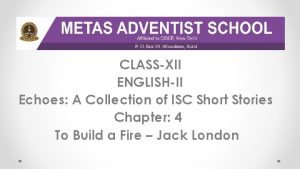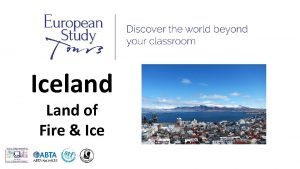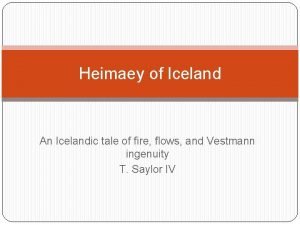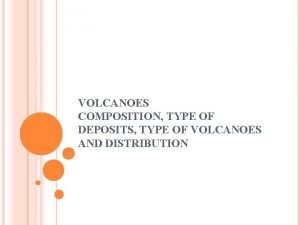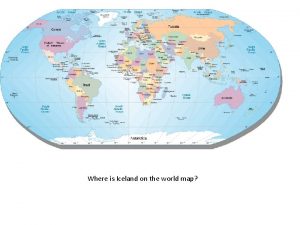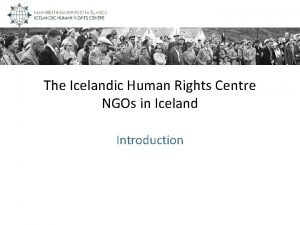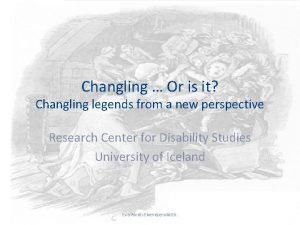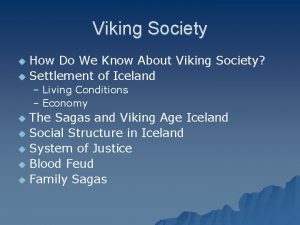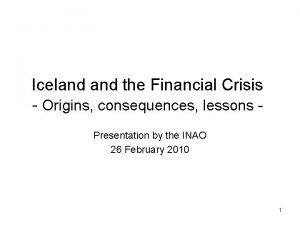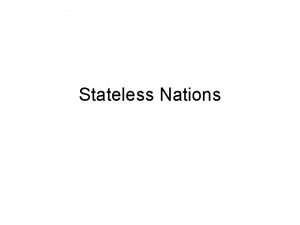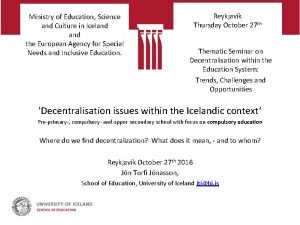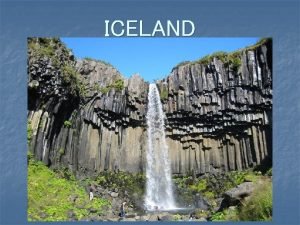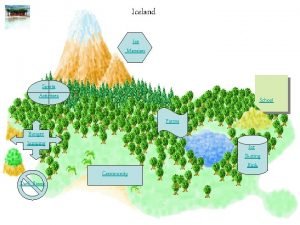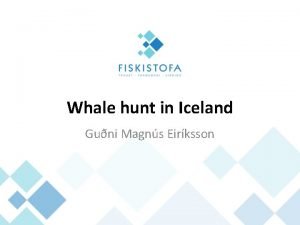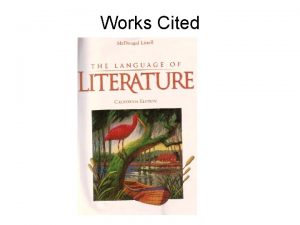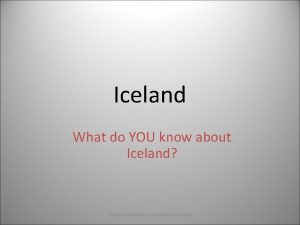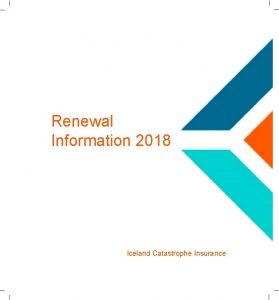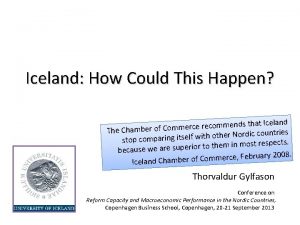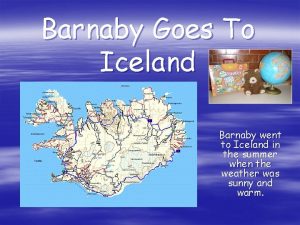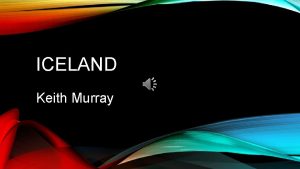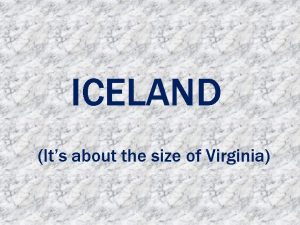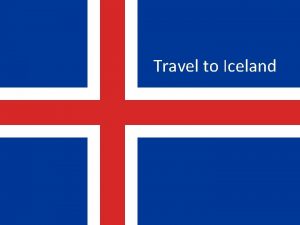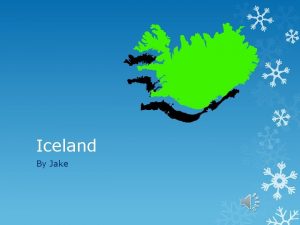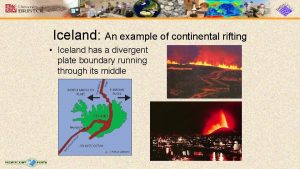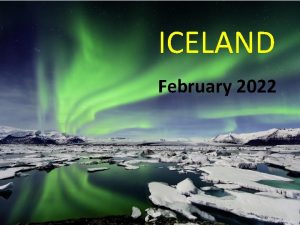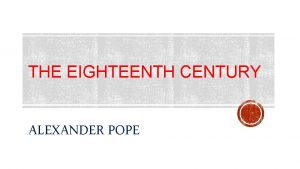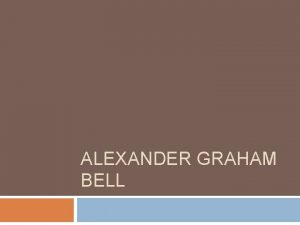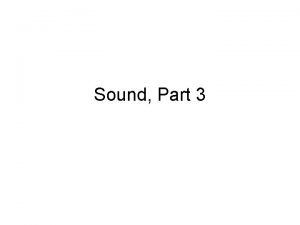Echoes from Iceland in the works of Alexander





















- Slides: 21

Echoes from Iceland in the works of Alexander von Humboldt and some contemporary scientists Leó Kristjánsson, University of Iceland

Alexander von Humboldt (1769 -1859) was one of the most versatile, productive and famous scientists of his generation. He collaborated with many others and influenced them as well as later generations. One may ask: does Iceland in any way appear in his work or in works of contemporary scientists with whom he was associeted ? The answer is “Yes” to some extent, and a few examples will be mentioned. The first of these concerns M. H. Klaproth, one of the founders of Analytical Chemistry. He e. g. analysed some minerals collected by v. Humboldt on his journeys. The paper below was published around 1796.

One connection of v. Humboldt with Iceland that I have come across, concerns Iceland spar, clear crystals of calcite found at a site near the Helgustaðir farm in Reyðarfjörður, East Iceland. They exhibited a strange optical phenomenon known as double refraction. This property was found in some other crystals but was less conspicuous there. The French Academy of Sciences offered a prize for an explanation of double refraction in 1808.

E. L Malus was awarded the 1808 Academy prize for studies which showed that light was altered in a certain way (“polarised”) by passing through Iceland spar. This discovery prompted much new research in Optics. v. Humboldt lived in Paris most of the time 1805 -27 and had close connections with Malus and other pioneers of the new science of light. One was J. B. Biot, who also wrote a paper with Humboldt in 1805 on the geomagnetic field.

Biot made extensive measurements on light that had been “polarised” by Iceland spar. He found out that this type of light was very useful in investigations of various organic liquids. His studies, continued later by L. Pasteur and others, led to a revolution in biological chemistry. Société d’Arcueil J. B. Biot Av. H Biot’s polarimeter, improved ca. 1855. d and g are prisms from Iceland spar

At Biot’s initiative, a young mineralogist named Alfred Des Cloizeaux was sent to Iceland in 1845 to inspect the unique Helgustaðir spar mine and study some other aspects of Iceland’s geology. More about him later.

In Paris, v. Humboldt found a lifelong friend in D. F. Arago, one of France’s greatest scientists. He made valuable discoveries in Physics, Astronomy, and Geodesy. An optical instrument designed by Arago, employing a crystal of Iceland spar for studying sky-light

Arago and v. Humboldt published together a paper in 1836, containing a table of barometric pressure at 32 sea-level localities between 33°S and 75°N. It was lowest in Iceland W-Greenland. This was one of the first indications of the presence of the low-pressure area in the North-Atlantic which has been much studied by meteorologists. v. Humboldt had previously written notable articles about temperature distribution on the Earth, stating in one: “Das Polareis vermindert sich überall, wo es frei abfliessen kann, wie in der Baffins-Bay und zwischen Island und Spitzbergen. ” He realized that the absence of seaice in the ocean north and northeast of Iceland has a positive effect on the climate of Western Europe. 1924 map of mean-pressure anomalies

In biographical works it is recorded that v. Humboldt and Arago discussed the construction of a solar clock using Iceland spar, analogous to a “sunstone” mentioned in medieval Icelandic literature. However, such a device was not made until 1848 (by Ch. Wheatstone). Humboldt gave a series of public lectures in Berlin 1827 -28, which survive in detailed manuscript notes of an unknown person attending them. Here, Humboldt states among other things: “Schon längst kannte man an dem kristallisirten Kalkspath (den sogenannten Isländischen Doppelspath) die Eigenschaft jeden Lichtstrahl der in denselben eindringt, in zwei Strahlen zu spalten. . ” …. and he goes on to describe discoveries of Malus, Arago and others in Physics and Astronomy made with Iceland spar

J. W. v. Goethe, who was very interested in light and color perception, wrote a book “Zur Farbenlehre” in two volumes, 1810. Arago observed in the same year that sheets e. g. of mica showed brilliant colors if they were viewed in white light between two Iceland spar crystals. T. J. Seebeck found that such colors also appeared in glass spheres. Goethe corresponded with Seebeck and felt he had to explain this; he did so in “Ergänzungen zur Farbenlehre” published in 1820. Contemporary drawing of the v. Humboldt brothers, between Fr. Schiller and J. W. v. Goethe

A section of “Ergänzungen zur Farbenlehre” which contains i. a. a discussion of the properties of Iceland spar, begins with the following lyric by v. Goethe on the color phenomena seen in Seebeck´s glass spheres with the aid of the Iceland-spar crystals: Möget ihr das Licht zerstückeln, Farb’um Farbe draus entwickeln, Oder andre Schwänke führen Kügelchen polarisieren, Dass der Hörer ganz erschrocken Fühlet Sinn und Sinne stocken. Nein ! Es soll euch nicht gelingen, Sollt uns nicht beiseite bringen, Kräftig wie wir’s angefangen Wollen wir zum Ziel gelingen. J. W. v. Goethe, ca. 1815 -20 v. Goethe’s ideas about light and color had some influence, but physicists did not approve of them. The above may be part of his response to their criticism.

Let us now turn to two of v. Humboldt’s collaborators, the mineralogist Gustav Rose and the zoologist C. G. Ehrenberg. They accompanied him on his journey to Siberia in 1829. Both of them did at some time study geological materials from Iceland.

Rose published in 1826 a short paper: “Ueber den Epistilbit, eine neue zur Familie der Zeolithe gehörige Mineralgattung” It is generally acknowledged that his samples came from Iceland. This is the only instance when a new crystalline mineral was first described and named on the basis of an Icelandic specimen. Rose later wrote papers dealing with other minerals from Iceland. Epistilbite: Rose’s 1826 drawing in the center

C. G. Ehrenberg made extensive studies on worldwide collections of one-celled animals (Infusoria) including some collected in Iceland in 1820 -21 by F. A. L. Thienemann. Ehrenberg’s contributions to this field were important, although some people thought he went too far in assigning the function of organs to features in their appearance. He was also one of the very first to note that the visibility of structural details in crystals, organisms and tissues under the microscope was sometimes enhanced by looking through Iceland spar. Ehrenberg’s foraminifera from Cuba

Ehrenberg received samples of volcanic ash from the major eruption of Mt. Hekla which began 2 Sept 1845. These were procured by J. G. Forchhammer and the Icelander Finnur Magnússon in Copenhagen, and by R. Bunsen (see later). Ehrenberg found some micro-organisms in the samples, and speculated on their origin. Finnur Magnússon, Archivist of the King

Early in 1846, King Christian VIII intended to send two persons to Iceland to survey the effects of the Hekla eruption. However, another five were then added to the expedition, including W. Sartorius von Waltershausen, A. Des Cloizeaux and the brilliant chemist Robert Bunsen. v. Waltershausen, who seems to have been the one to suggest this change, was a relatively unknown geologist who had mostly been studying Etna. v. Waltershausen Hekla 1846 We may ask: how was the King persuaded to sponsor this enlarged effort, including provision of two military vessels ? Could Alexander von Humboldt have been an intermediary ? Let us look at some circumstantial evidence. . .

1. v. Humboldt was one of the world’s foremost volcanologists, and had published papers which included mention of Iceland’s volcanoes. 2. v. Humboldt was greatly admired by King Christian who visited him in 1843. In the summer of 1845 v. Humboldt came to Copenhagen as chamberlain of King Friedrich Wilhelm III of Prussia, driving through the city with Finnur Magnússon. 3. v. Waltershausen had been working for C. F. Gauss in Göttingen, who was making geomagnetic measurements in collaboration with v. Humboldt. Besides, he may have known v. Humboldt through his family’s contacts with v. Goethe.

Much new information about Iceland’s geology was acquired in the 1846 expedition, some of which is mentioned in Band IV of v. Humboldt’s Kosmos. The best-known aspect may be Bunsen’s explanation of geyser eruptions, but a more important consequence is now forgotten to most: Bunsen was namely the first scientist to study the physical nature of the color of water: see the next slide.

(1849) This paper initiated in 1869 a landslide of new studies on the interaction of light and material particles, lasting for decades. Among those contributing significantly to these studies were Lord Rayleigh and A. Einstein. In the experimental part, Iceland spar was once more indispensable.

The above-mentioned A. Des Cloizeaux later became one of the main proponents of new microscopical techniques in mineralogy, which employed Iceland spar prisms. Among other participants in that development were Gustav Rose and especially F. Zirkel of Bonn who travelled in Iceland in 1860 and wrote his doctoral thesis on Icelandic rocks. Þórarinn E. Tulinius A large supply of Iceland spar crystals was needed for the microscopes and other polarized-light instruments. These seem to have come mostly from Helgustaðir, the production peaking in 1863 -72 and 1895 -1910 under the direction of Carl Tulinius and his son Þórarinn. Petrographical microscope, 1870 -75

Concluding remarks In various ways, Iceland played a part in research undertaken by Alexander von Humboldt and contemporary natural scientists of his acquaintance. I have mentioned in this context e. g. studies on minerals, climate, micro-organisms, volcanism, and geothermal activity. “In der deutschen Wissenschaft hat Islands Naturwelt stets weitgehende Beachtung gefunden” (Hans Spethmann, 1930). In research activity connected to Iceland undertaken by many other scientists both of v. Humboldt’s generation and successive ones, influence from him can be discerned, either directly or through encouragement from his initiatives. In particular, one is pleased to know that v. Humboldt was familiar with crystals of Iceland spar, and that people close to him published important papers on its properties and applications. Through recent historical studies by the author, Iceland spar is turning out to have been a very significant factor in the development of several important fields of modern science and technology. (Adapted from a talk given to the Alexander von Humboldt Society of Iceland, Feb. ’ 06)
 Echoes singular form
Echoes singular form Echoes a collection of isc short stories
Echoes a collection of isc short stories Chapter 17 atlantic revolutions and their echoes
Chapter 17 atlantic revolutions and their echoes Chapter 16 atlantic revolutions global echoes
Chapter 16 atlantic revolutions global echoes Safety at streetworks and roadworks
Safety at streetworks and roadworks Iceschools
Iceschools Icelandic tale
Icelandic tale Slidetodoc.com
Slidetodoc.com Iceland map world
Iceland map world Ngos in iceland
Ngos in iceland Iceland changlings
Iceland changlings Viking
Viking Iceland economic crisis
Iceland economic crisis Stateless nation examples
Stateless nation examples Ministry of education iceland
Ministry of education iceland Iceland climate
Iceland climate Slidetodoc.com
Slidetodoc.com Fault line iceland
Fault line iceland Mansion sports
Mansion sports Iceland scavenger hunt
Iceland scavenger hunt Tỉ lệ cơ thể trẻ em
Tỉ lệ cơ thể trẻ em Lời thề hippocrates
Lời thề hippocrates

